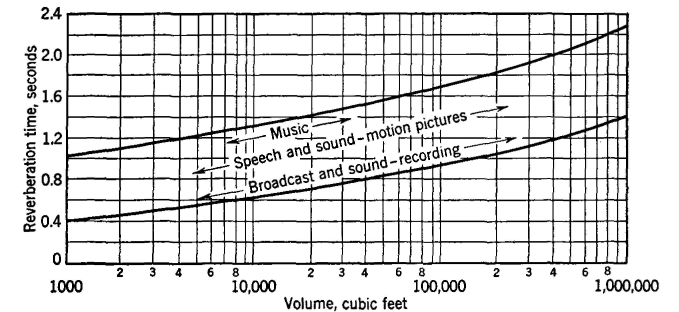| Electrical Communication is a free textbook on the basics of communication technology. See the editorial for more information.... |

|

Home  Fundamentals of Acoustics Fundamentals of Acoustics  Acoustics of Auditoriums Acoustics of Auditoriums |
|||






|
|||
Acoustics of AuditoriumsThe reverberation time of an auditorium usually is the most important acoustical factor determining its suitability for both speech and music. The best reverberation time can be found from Fig, 4, which is based on curves given by several authorities.10,14,15,16 If the reverberation time is too long, then succeeding speech sounds will interfere and the words will tend to become indistinguishable. If the reverberation time is too short, then the speech sounds will be absorbed too quickly and the maximum intensity to which the sounds rise will be low. If an auditorium is to be used largely for music, a longer reverberation time is permissible than for speech, because music sounds best if the various tones are blended. The curves of Fig. 4 are for a frequency of 512 cycles; but, as Table I shows, sound-absorbing properties vary with frequency. For this reason, the reverberation time will be different at various frequencies. It is often satisfactory to use 512 cycles for auditorium design purposes. Curves are available15,16 for determining the best reverberation time at other frequencies.
The practicable method of ensuring a correct reverberation time is to include sufficient sound-absorbing material. This should, of course, be installed when the auditorium is constructed, although it may be added later. For good results the shape of an auditorium should be more or less rectangular, without large curved surfaces. The person speaking may be unable to supply sufficient sound energy to be heard satisfactorily in all parts of the auditorium. Accordingly, sound-amplifying equipment is installed in large auditoriums. Such equipment consists of a microphone, a vacuum-tube amplifier, and a system of loudspeakers. The acoustic output power requirements for such a system will depend on the size, reverberation time, extraneous noise level, and similar factors,5 An appropriate idea of the acoustic power required in auditoriums of given size can be obtained from Fig. 5. If a sound-amplifying system is used it is permissible for an auditorium to have a lower reverberation time, and a lower reverberation time reduces acoustic feedback to the sound-amplifying system.
|
|||
Home  Fundamentals of Acoustics Fundamentals of Acoustics  Acoustics of Auditoriums Acoustics of Auditoriums |
|||
Last Update: 2011-05-13


